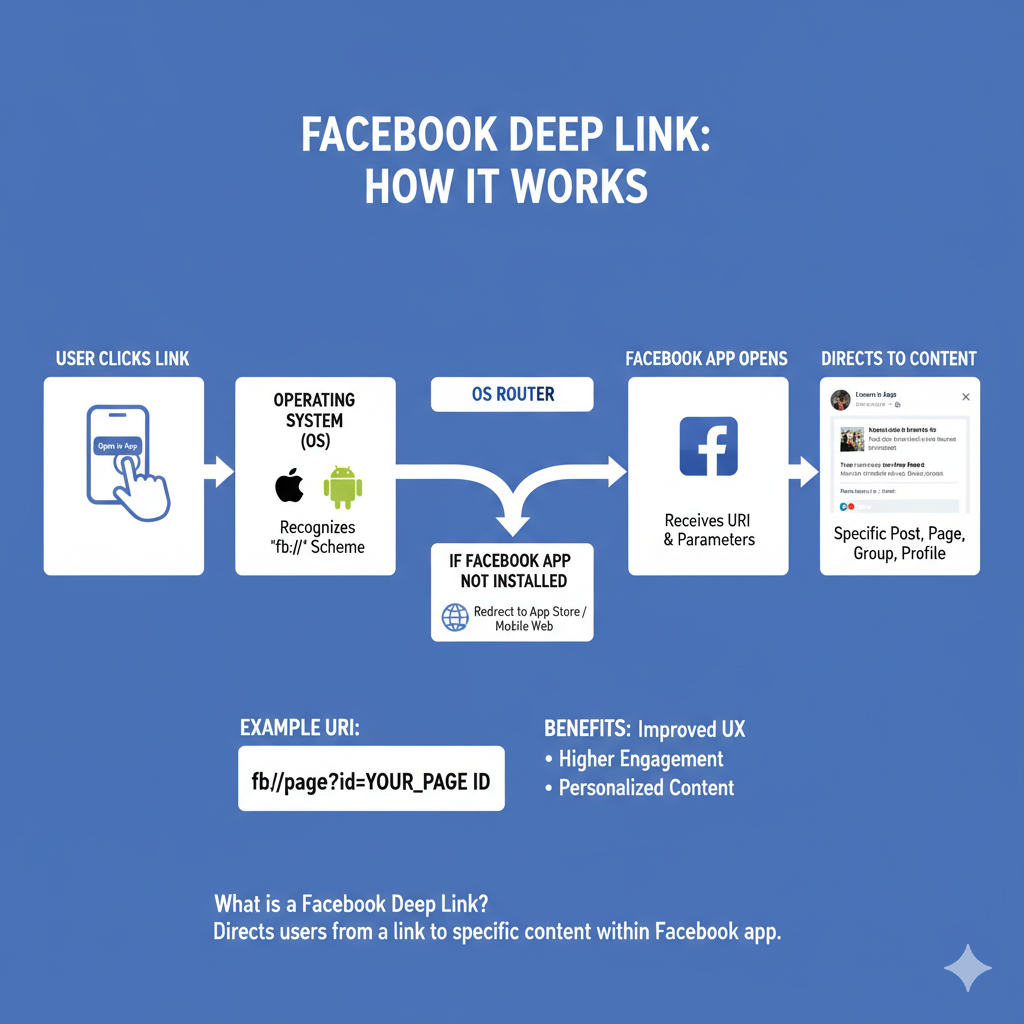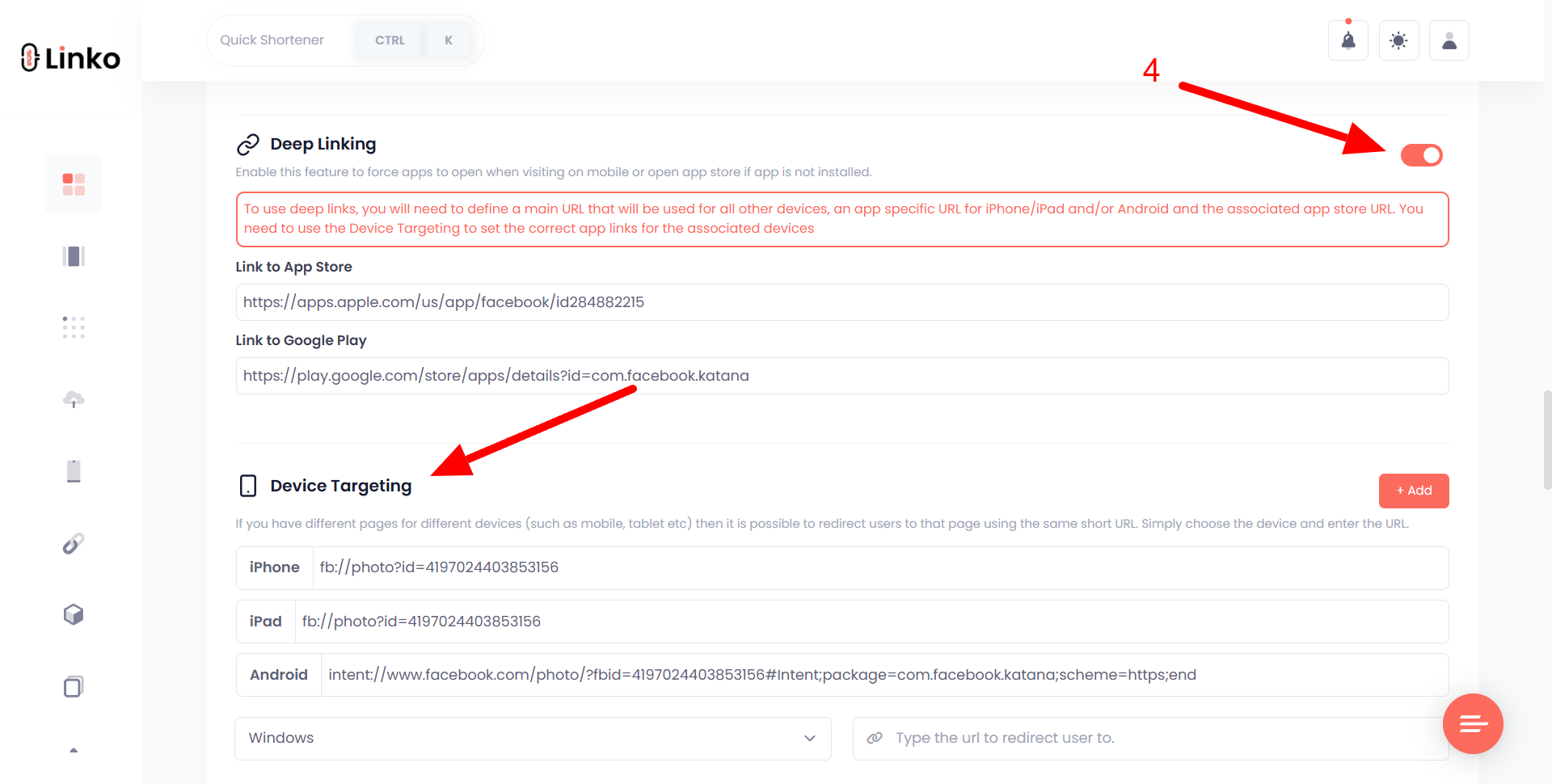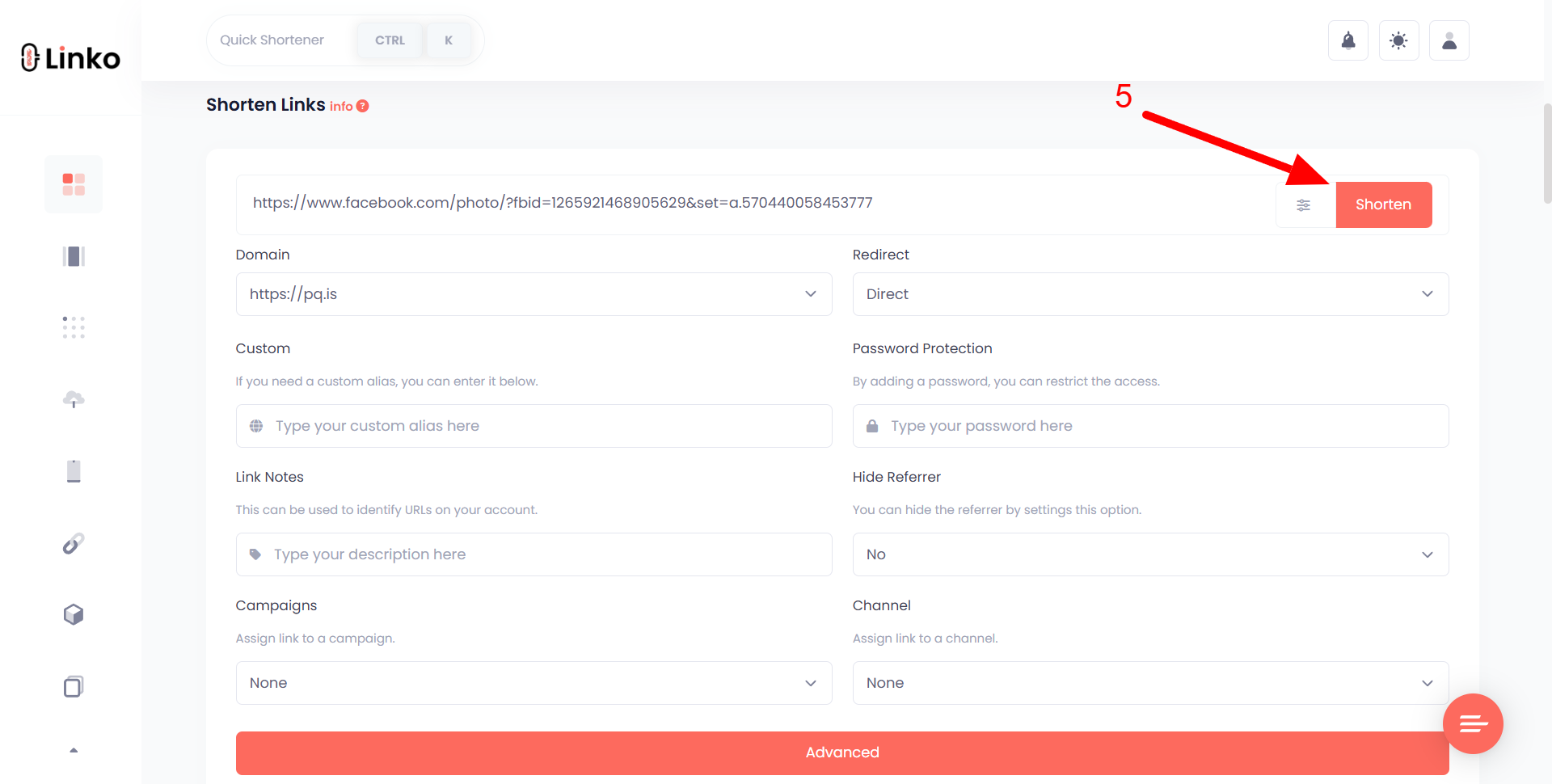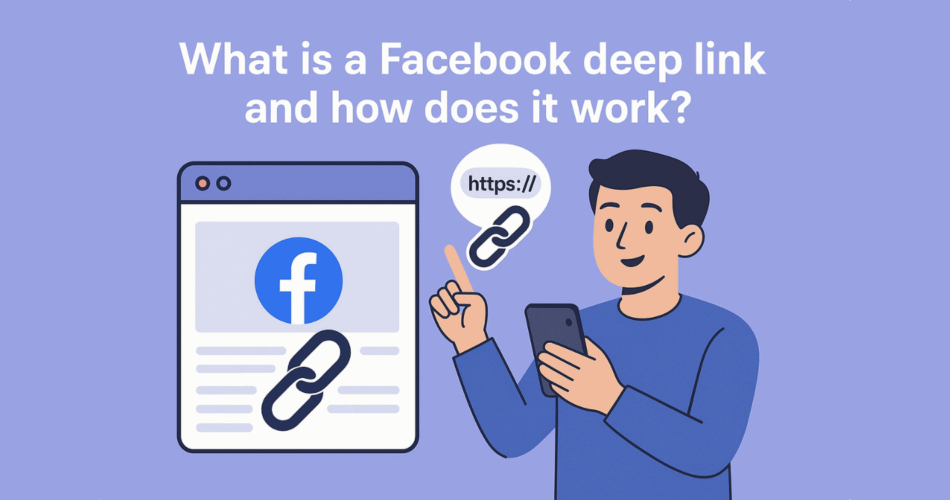If you have ever clicked a Facebook link that instantly opened the app instead of a browser, you’ve already experienced a deep link.
These special links take users straight to the right place inside the Facebook app, whether that’s a photo, page, video, or even an event.
For marketers, app owners, and social media managers, creating Facebook deep links can make campaigns smoother and engagement stronger.
In this guide, we’ll break down everything you need to know:
- How deep links work,
- What types of Facebook content they support,
- How to create them step by step using Linko, and some real-world examples.
Let’s start by understanding the basics.
Key Takeaways
A Facebook deep link takes users directly to a specific page, post, video, group, event, or profile inside the Facebook app instead of the browser. This improves navigation and creates a smoother user experience.
Deep links work for multiple content types including videos, profiles, events, pages, groups, and posts. Marketers often use them to send traffic directly to in-app destinations.
You can paste any Facebook URL into a tool like Linko, enable deep linking, and get app-ready links for iOS and Android. These links include fallbacks for users who don’t have the app installed.
Deferred deep links allow new users who haven’t installed the app yet to be redirected to the App Store or Google Play, and after installation, they land on the intended Facebook content. This improves onboarding.
Always test your links across devices, add fallback URLs, use them in ads and campaigns, and monitor performance. This ensures smooth navigation and better engagement across your campaigns.
What is a Facebook deep link and how does it work?
A Facebook deep link is a smart link that doesn’t just open Facebook in a browser.
Instead, it directs the user straight into the Facebook mobile app at the exact piece of content you want them to see.
Deep links work by embedding an app-specific URI scheme or intent into the link.
When tapped, the device checks if the Facebook app is installed.
- If it is, the app opens at the right content.
- If not, the user can be redirected to the App Store or Google Play.
This ensures a smooth user experience regardless of device.

How is a Facebook deep link different from a regular link?
A regular Facebook link usually opens in a web browser, like Chrome or Safari.
A deep link, on the other hand, is designed to open inside the app.
Here’s a quick comparison:
| Type of Link | Where It Opens | User Experience |
|---|---|---|
| Regular link | Web browser (or app if manually redirected) | Often slower, requires login |
| Deep link | Directly in the Facebook app | Faster, seamless, app-native experience |
This difference matters because deep links reduce friction.
Users don’t waste time logging in again on the web; instead, they land exactly where you want them in the app.
Why are deep links useful for apps, pages, and campaigns?
Deep links are powerful for engagement and conversions.
Instead of losing users between the browser and app, you give them a direct path.
For example:
- A business can share a deep link to its Facebook page in an email, ensuring users open the page inside the app.
- An influencer can drop a deep link to a video or post, boosting views since it skips browser distractions.
- Marketers running ads can connect campaigns to Facebook app destinations, which increases interaction.
The result? More engagement, less drop-off, and higher campaign efficiency.
What happens when a deep link opens on different devices?
The behavior of deep links depends on the device.
- iOS devices: If the Facebook app is installed, the deep link opens the app directly. If not, the user can be redirected to the App Store or the fallback browser link.
- Android devices: Similar behavior, but the link may use an intent URL to open the app. Without the app installed, the user goes to Google Play or the fallback web page.
This cross-device reliability makes deep linking an essential tool for anyone targeting both iOS and Android audiences.
Which types of Facebook content can you open with deep linking?
Facebook supports multiple content types with deep linking.
This means you’re not limited to just profiles or pages; you can link to almost anything.
How do you make a deep link to a Facebook page or profile?
To create a deep link to a page or profile, you use its unique Facebook URL.
When processed through a deep linking tool like Linko, the link is converted into one that opens directly inside the app.
Facebook page deep link example:
- Normal URL:
https://www.facebook.com/YourPageName - Deep link:
fb://page/?id=123456789
Facebook profile deep link example:
- Normal URL:
https://www.facebook.com/YourProfileName - Deep link:
fb://profile/?id=123456789
This way, your audience lands inside the app at your profile or business page, not in a browser window.
Can you generate deep links for posts (photos) and videos (watch)?
Yes, you can deep link to individual photos and videos (watch). This is particularly useful for creators, brands, and advertisers.
Post (photo) deep link
Sharing a deep link to a viral post ensures it loads inside the Facebook app where users can like, comment, and share instantly.
Facebook post (photo) link example:
- Normal link:
https://www.facebook.com/photo/?fbid=123456&set=gm.123456 - Deep link:
fb://photo?id=1234567890
Video (watch) deep link
A deep link to a video can drive higher watch times since it loads natively in the app’s player.
Facebook video (watch) link example:
- Normal link:
https://www.facebook.com/watch?v=123456789 - Deep link:
fb://watch?id=123456789
How do deep links work for Facebook groups and events?
Groups and events are community-driven areas on Facebook, and deep linking plays a huge role here.
Group deep link
A group deep link allows you to direct members straight into discussions inside the app. This keeps activity high since they bypass the browser login wall.
Facebook group link example:
- Normal link:
https://www.facebook.com/groups/NAME - Deep link:
fb://group/?id=GROUP_NAME
Event deep link
An event deep link makes it easier for users to RSVP, check event details, or invite others, all inside the app.
Facebook event link example:
- Normal link:
https://www.facebook.com/events/123456789 - Deep link:
fb://event/?id=123456789
Both types strengthen community engagement and reduce friction.
How do you create a Facebook deep link step by step with Linko?
The easiest way to generate a Facebook deep link is by using Linko, which automates the process for both iOS and Android.
Here’s how you can do it:
Log in or sign up
- Access your Linko dashboard.
- If you don’t have an account, you can subscribe to a Business or Agency plan.
Paste your Facebook URL
- Copy the link from a Facebook post (photo), video (watch), profile, event, page, or group and paste it into the Linko input field.
Open advanced settings
- Click the Advanced icon, then select the Advanced button to see extra link features.

Enable deep linking
- In the dropdown panel, activate the Deep Linking option.
- At this point, Linko automatically creates app-specific links for iOS and Android, with fallback URLs for the App Store and Google Play.

Shorten your link
- Scroll back up and click the Shorten button.

Share your new deep link
- You now have a shortened, app-ready deep link. You can use it in ads, emails, SMS, or QR codes for campaigns.
How does Facebook deferred deep linking help with new users?
Deferred deep linking helps new users by directing them to the right in-app content even if the app is not yet installed.
Instead of losing the user after they click a link, the system first guides them to download the app and then automatically sends them to the intended page or feature once the app opens.
This is a powerful way to avoid drop-offs during user acquisition.
Imagine someone clicks on a Facebook ad promoting a product inside your shopping app.
Without deferred deep links, they would land only on the app’s homepage after installation, which may confuse them.
With deferred deep linking, the user lands exactly on the product page they originally wanted, creating a smooth and relevant experience.
What makes deferred deep links different from regular deep links?
Deferred deep links are different from standard deep links because they work even when the app is not installed at the time of the click.
Regular deep links only function if the app already exists on the user’s device.
Here’s a quick comparison for clarity:
| Feature | Regular Deep Link | Deferred Deep Link |
|---|---|---|
| Works without app installed | ❌ No | ✅ Yes |
| Best for existing users | ✅ Yes | ✅ Yes |
| Best for new users | ❌ No | ✅ Yes |
| Directs to exact in-app location | ✅ Yes | ✅ Yes |
This difference makes deferred deep linking a stronger choice for campaigns that target both new and returning users, especially through Facebook ads.
When should you use deferred deep links on iOS or Android?
You should use deferred deep links when your marketing campaign involves acquiring new users on iOS or Android, and you want them to land on a specific in-app screen after installation.
For example:
- iOS apps: Use deferred deep links in App Store campaigns or Facebook ads that target iPhone users who do not already have your app.
- Android apps: Apply deferred deep links in Google Play-driven installs where you want to show an onboarding screen, discount code, or product directly after the app opens.
By tailoring the experience, you ensure that users don’t feel lost after downloading your app.
Instead, they immediately see relevant content, which reduces churn in the very first interaction.
What best practices should you follow for Facebook deep linking?
To get the best results from Facebook deep linking, follow practices that improve both technical setup and user experience.
1. Always test your links before launch
Use multiple devices and OS versions to ensure your links redirect correctly. Broken deep links hurt trust and reduce conversions.
2. Keep URLs clean and descriptive
A clear slug (example: appname://product/12345) improves readability and tracking. Avoid messy parameters where possible.
3. Use deferred deep linking for acquisition campaigns
Targeting new users? Always configure deferred deep links so they land on relevant screens after installation.
4. Map fallback destinations correctly
If the app is unavailable, make sure users land on a mobile website or app store listing instead of a blank page.
5. Measure and analyze performance
Track which deep links drive the most installs, retention, or purchases. This data helps refine future campaigns.
Following these best practices ensures smoother navigation for users and better results for marketers.
Final thoughts
Facebook deep links are a powerful way to connect your posts, pages, videos, groups, event, and profile with in-app content.
Regular deep links work well for existing users, while deferred deep links shine for new user acquisition by bridging the gap between installation and onboarding.
The most successful apps use a mix of both approaches, guided by best practices such as testing links, setting correct fallback URLs, and aligning campaigns with user expectations.
By implementing these strategies, you can turn clicks into lasting engagement instead of losing users mid-journey.
FAQs
Can I create Facebook deep links without coding?
Yes. Tools like Facebook Ads Manager, Firebase Dynamic Links, and SaaS platforms such as Linko.me let you build deep links without heavy technical work.
Do deferred deep links work on both iOS and Android?
Yes. They are supported on both platforms, though setup may differ slightly due to Apple’s Universal Links and Android App Links.
What happens if a user clicks a deep link but already has the app installed?
They will be taken directly to the targeted content in the app, skipping the app store.
Can Facebook deep links help with retargeting campaigns?
Absolutely. You can bring existing users back to abandoned carts, promo pages, or unfinished actions using deep links in Facebook ads.
Are Facebook deep links safe to use?
Yes. They are safe as long as they are configured properly and point to verified domains or app content.


Comments